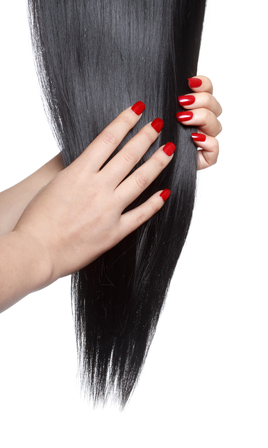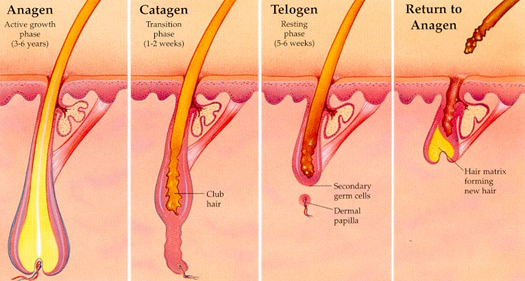Hello lovelies!

How fast does hair grow? This is a question that is likely to cross your mind if you are desperate for longer hair. Well, for some the answer may be not fast enough, for others it may seem as if their hair doesn’t grow at all. However, the truth is, as long as you’re alive, your hair is always growing! In fact, hair has a specific rate at which it grows.
Can You Really Grow Hair Faster?
Growth Rates
While our hair may seem like it grows when it wants to, human hair actually has a specific rate at which it grows, this is called a growth rate. According to the U.S Center for Disease Control (CDC), scalp hair grows at an average rate of 0.50 inches (1.25 cm) per month, or one-eighth of an inch every week. This means the average person grows 6 inches of hair per year. Of course stress, diet and certain illnesses can slow or stop the rate of your hair growth, but under normal circumstances, your hair is always growing. Primarily, genetics determines natural growth rates, which differs from person to person, and in some cases, no two people within the same family will have the same growth rate. Here is a bit of science for you all about how hair grows.
Growth Cycles
Hair grows in a series of phases, also known as cycles, the first being the Anagen phase. The Anagen phase is the period in which your hair actively grows. At any given time, 90 percent or more of your hair is in the Anagen phase, meaning 90 percent or more of your hair is always growing. This phase varies in length anywhere from 2 years all the way up to 8 years. Every hair on your head will not grow at the same pace, nor will they have the same Anagen phase. Factors such as ethnicity and age affects the length of this phase or the terminal or longest length your hair can reach. This is the most important stage in the hair growth cycle in regards to making your hair grow faster.
Lengthening the anagen phase, or the amount your hair grows in your set anagen phase, is the key to obtain longer hair at a faster rate (not necessarily increase the growth rate). There are a couple of things that supposedly increase the anagen phase of the growth cycle.
Lengthening the Anagen Phase
If you want to grow longer hair, longer than what even your genetics determines you can grow, the anagen phase is the phase in the hair growth cycle that you absolutely need to target. Now, it may seem impossible to lengthen something that’s already genetically predetermined, but once again, science proves to us that it is possible.
There are 3 scientifically proven ways that we know of thus far that can lengthen the anagen phase and allow humans to grow longer hair than what was previously thought possible. I wrote about those three hair growth methods in another article. You can check it out here!
The second phase of hair growth, the Catagen phase, is a two week transitional phase in which the hair follicle renews itself. During this phase, the hair loses it’s blood supply and doesn’t grow. In fact, the hair follicle shrinks to about 16 percent of it’s original length during this growth phase.
The last growth phase, the telogen phase, is a one to four month resting phase where the hair lays dormant. At any given moment, about 10 percent of your hair is at rest in this phase. When the telogen phase is complete, a new growing strand pushes the telogen strand out of the follicle and the anagen phase starts again for that particular follicle.
How Fast Does Hair Grow By Ethnicity
 Ultimately, scientists claim certain factors such as ethnicity, age and other factors determines how fast your hair grows. I found a study that purports that Asian hair has the fastest growth rate, with an average growth rate of 6.3 inches per year. The study found that Caucasian hair has the second fastest growth rate, with an average growth rate of 5 inches per year. African hair had the slowest growth rate with an average growth rate of 4.3 inches per year.
Ultimately, scientists claim certain factors such as ethnicity, age and other factors determines how fast your hair grows. I found a study that purports that Asian hair has the fastest growth rate, with an average growth rate of 6.3 inches per year. The study found that Caucasian hair has the second fastest growth rate, with an average growth rate of 5 inches per year. African hair had the slowest growth rate with an average growth rate of 4.3 inches per year.
The difference in growth rates is supposedly attributed to the difference in the shape and thickness of individual hair strands. If you take a cross section of a strand of Asian hair, the hair strand will have a round, cylindrical shape. If you take a cross section of a Caucasian hair strand, the hair strand will have a flatter, more oval shape. If you take a cross section of a African hair strand, the hair strand will have a flatter, more oval shape than any other hair type.
While the studies results appear valid, I think growth rates for all ethnicities tend to be fairly the same, in contrast to this study. Here is why:
1. The study only followed about 30 women, and the study only followed these women for one point in time during the year as opposed to multiple times during the year.
2. All hair types have the same number of cuticle layers, hair protein complex and hair strength, which are all things that factor into how our hair grows.
3. The study doesn’t say what condition the women’s hair was in at the time of the study; this would greatly affect how much length each woman retained. When trying to grow long hair, it is the condition of your hair and how much growth you retain that matters most, not necessarily how fast your hair grows.
 As a whole, Asian women, especially women who follow Indian hair care practices, traditionally have more hair practices that are conducive to growing long hair. Caucasian women and African women typically have hair practices that aren’t as conducive to growing longer hair (we tend to dye, relax, style and just outright abuse our hair more than other women), hence the assumed shorter growth rates in the study. The truth is there is a standard growth rate, but it’s how you handle and care for your hair that greatly affects how much length you retain; certain hair practices can cause damage to the hair and give the appearance of a slower growth rate when in fact the hair may be breaking as a result of damage.
As a whole, Asian women, especially women who follow Indian hair care practices, traditionally have more hair practices that are conducive to growing long hair. Caucasian women and African women typically have hair practices that aren’t as conducive to growing longer hair (we tend to dye, relax, style and just outright abuse our hair more than other women), hence the assumed shorter growth rates in the study. The truth is there is a standard growth rate, but it’s how you handle and care for your hair that greatly affects how much length you retain; certain hair practices can cause damage to the hair and give the appearance of a slower growth rate when in fact the hair may be breaking as a result of damage.
Retention More Important than Growth Rate
 No matter how fast your hair grows, if you don’t retain much of your hair growth, your hair won’t reach longer lengths. So exactly what is retention? Retention is simply preserving as much hair that grows out of your scalp and keeping it as healthy as possible.
No matter how fast your hair grows, if you don’t retain much of your hair growth, your hair won’t reach longer lengths. So exactly what is retention? Retention is simply preserving as much hair that grows out of your scalp and keeping it as healthy as possible.
For instance, if your hair grows a 0.5 inches per month, but you are trimming 0.25 inches from your hair each month, or if you get a 1 inch hair cut three times a year, within a years time you will only retain 3 inches of hair. However, if your hair grows at a rate of 0.4 inches a month (a hypothetical figure) and you adopt healthy hair care practices, and you preserve each inch of hair, within a years time you will retain 4.8 inches of hair.
The ends of the hair are the most important portion of the hair to retain. That is because the ends of the hair are the oldest part of the hair, so they are typically more exposed to damage. Several things can bring about damage to the hair, from everyday wear and tear to styling the hair with flat irons. The bottom line is that the ends of the hair will eventually become weathered, but with healthy hair care practices it is possible to give the ends of your hair the utmost care and maximize how much hair you retain.




